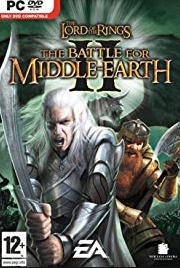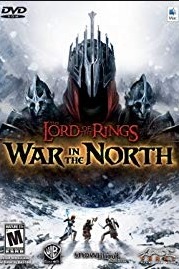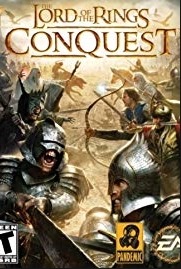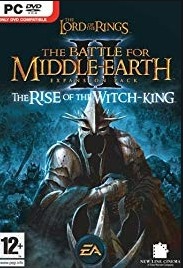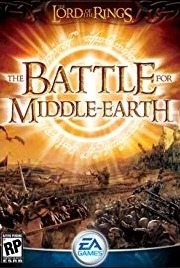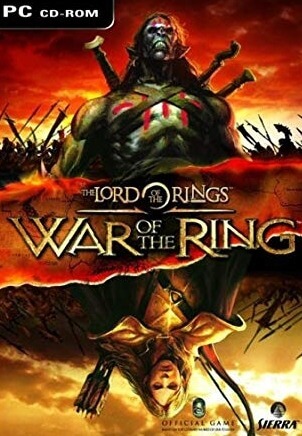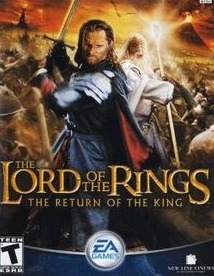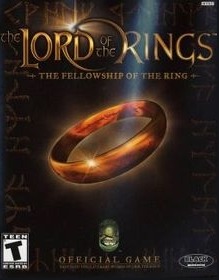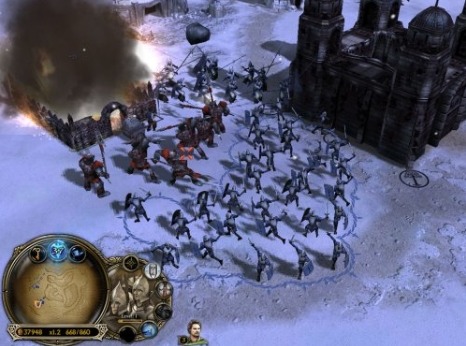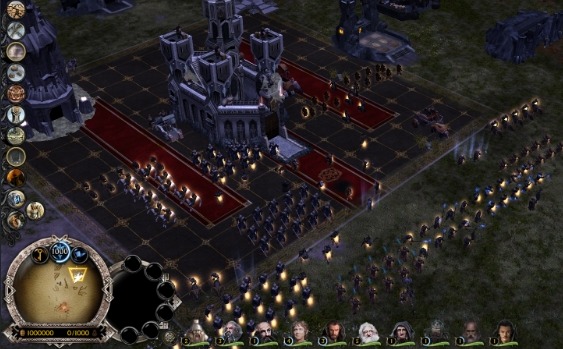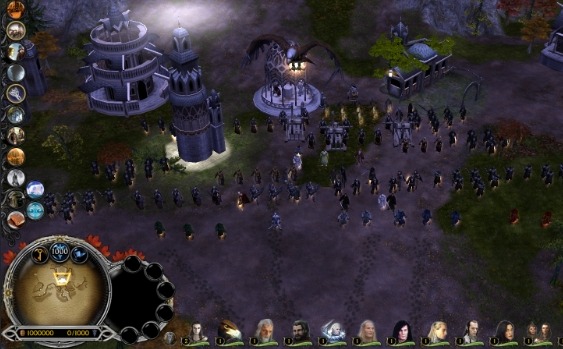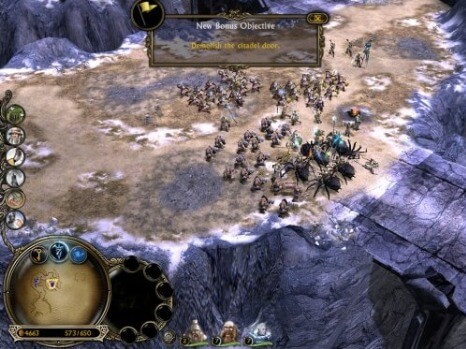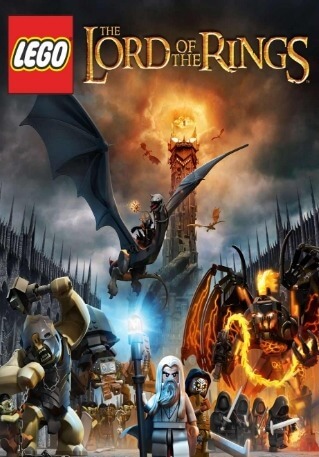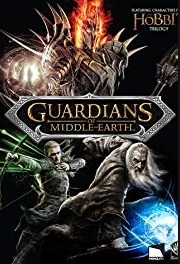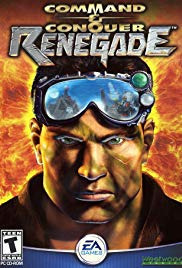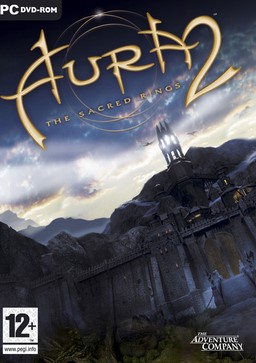The Battle for Middle-earth II is a real-time strategy game. Similar to its predecessor, the game requires that the player build a base with structures to produce units, gather resources, research upgrades, and provide defenses. Units are used to attack the enemy and defend the player's base. Players win matches by eliminating all enemy unit producing structures. Unlike the first game, the player can build an unlimited number of structures anywhere on the map, allowing for more freedom in base building and unit production. Players can build walls to defend their base; however, the walls can only be constructed within a certain proximity to the players fortress. They can also construct arrow and catapult towers on building plots around a fortress to provide defensive support and basic protection. Along with this, each factions' fortress is uniquely equipped with a special power reached only by purchasing necessary upgrades. The game's HUD, called the Palantír, shows the player's hero units and their abilities, a mini-map, and objectives.
Units are classified into one of several classes: infantry, ranged, pikemen, cavalry, or siege. Each unit class has unique strengths and weaknesses, emphasizing the importance of properly matching up units in battle to increase their effectiveness. Hero units are unique in that only one of each can be created; they consist of characters from the novel, such as Aragorn, Legolas, Gimli, Saruman, Nazgûl, Mouth of Sauron, Arwen and Shelob, or are created via the game's Hero Creator (only accessible via the PC version). If the player kills Gollum, a non-player character, they are rewarded with the One Ring. The item can be used to summon one of two ring heroes for a price of 10,000 resources, Galadriel and Sauron, depending on the player's faction. Ring heroes have extremely strong armor and powerful attacks, making them among the game's most over-powered units.
The War of the Ring mode carried over from the first game in the series combines turn-based strategy elements with real-time skirmishes. Middle-earth is divided into territories; players can construct buildings to produce troops only in a claimed territory. During each turn, the player can move their armies into neutral and enemy territories to take control of them. While neutral territories are conquered by simply entering them, enemy territories must be wrested from the other player by defeating them in a skirmish. Troops can be garrisoned in conquered territories to defend against enemy attacks. When the player chooses to attack another territory, or one of their territories is being invaded by an enemy, they can either simulate the match and let the computer determine the outcome, or play the match by commanding the units in real time. The winner of the skirmish gains the territory, and all surviving units gain experience points. To win the game, players must either control the enemy's capital territory, or take over a given number of territories in Middle-earth.
The Battle for Middle-earth II introduces three new factions with unique units and heroes: Goblins, Dwarves, and Elves. Rohan and Gondor are combined into one faction called Men of the West. Along with Mordor and Isengard from the first game, there are six playable factions. The troops of Gondor provide a solid offense and defense with standard infantry and archers, and the Rohirrim of Rohan act as elite cavalry. The Elven archers are effective at inflicting damage from a distance, and their support units, the Ents, can perform a combination of melee and siege attacks, they are often considered the strongest defensive faction due to their strong missile units and powerful 'silverthorn arrows'. Although slow and expensive, Dwarven infantry, pikemen, and axe-throwers are very powerful and well-armored allowing them to prevail in even the longest clashes with enemy troops. A collection of wild creatures and beasts of Middle-earth make up the Goblin faction, this includes goblins, trolls, spiders, and dragons, which are effective in large numbers. Their only advantage is that the goblin archer and soldier units are cheap to make at only 75 resources and build faster than other basic infantry. Isengard troops are highly trained Uruk-hai under Saruman's command. Berserkers are used by Isengard as one-man armies that move extremely fast and deal significant damage (particularly to enemy buildings and heroes). Additionally, Isengard is the only Evil faction that can build walls. Mordor forces are a mixture of Orcs, Men, Trolls, Mumakil, and Sauron's lieutenants. Mordor Orcs have tough armor, making them useful for absorbing enemy damage while stronger units attack enemies. Trolls contribute greatly to the Mordor offensives, having strong melee attacks and the ability to throw boulders or wield trees like swords.
Plot
Set in the regions of northern Middle-earth, the game focuses on the events of the War in the North. For the sake of gameplay, the game takes several liberties with Tolkien's works and the film trilogy. Some characters were altered in their appearances, abilities, and roles; for instance, a combat role in the game is given to Tom Bombadil, a merry and mysterious hermit who appears in The Lord of the Rings but does not take part in the war. In addition, Tolkien's earlier novel The Hobbit lends several elements to the game, including characters such as the Giant Spiders from Mirkwood. The story for The Battle for Middle-earth II is divided into Good and Evil Campaigns. Both campaigns focus on the battles fought by the newly introduced factions: the Elves, Dwarves, and Goblins. The player goes through nine fixed missions in either easy, medium, or hard difficulty mode. Narrated cut scenes provide plot exposition between missions.
The Evil Campaign follows an alternative version of the War in the North. Sauron sends the Mouth of Sauron and the Nazgûl to the North to muster wild Goblins. His lieutenants lead the Goblin army and launch an assault on the Elven forest of Lórien. Despite heavy resistance, the forest is overrun, with Celeborn slain and Galadriel having fled to Rivendell; even Caras Galadhon collapses under the sheer force of the massive invasion. The Mouth peers eagerly into the captured Mirror of Galadriel for his next attack, as his Goblins celebrate their triumph over the Elves amidst the ruins of the once-mighty ancient stronghold. Another group of Goblins, led by the Goblin King Gorkil, attacks the Grey Havens by land and sea. The Elven port is destroyed and captured, and the march across Eriador begins; Hobbits of the Shire are chosen as the next target. Gorkil's horde manages to crush the Hobbits and burn their country to the ground, but Saruman's servant Gríma Wormtongue, suddenly appears with a large army of Isengard Uruks and claims the land for his master. The Goblins annihilate the well-trained army and kill Wormtongue, taking the Shire for themselves.
Gorkil continues marching west and besieges Fornost, the fortified ruins of the ancient capitol of Arnor. The defenders, consisting of the Dúnedain and Dwarves led by Glóin, crumble under the relentless Goblin attacks, and Eriador falls under Goblin control. Sauron launches a concurrent campaign east of the Misty Mountains. The orcs from Dol Guldur eliminate the Elves and the Ents that guard the Forest Road in Mirkwood, defeating the Elven lord Thranduil. After the fall of Mirkwood, the Mouth of Sauron leads his horde to Withered Heath to recruit the Dragon Lord Drogoth, after destroying the Dwarves in the area. To finally rid Sauron and Middle Earth of the Dwarves, The Mouth of Sauron attacks the human city of Dale and the Dwarven stronghold of Erebor, led by King Dain. For the final battle against the Good factions in the North, the Goblin horde and Sauron's forces from Mordor converge at Rivendell, the last surviving stronghold against Sauron in Middle-earth. Eagles, the Dead Men of Dunharrow, Galadriel and her surviving Elves, and the remnants of the Fellowship of the Ring arrive to help Arwen and Elrond, but Sauron (having attained full power through recovering the One Ring from the dead Frodo) and all his gathered forces enter the battle and completely destroy the remaining Good forces in the North.
The Good Campaign opens after the Fellowship of the Ring has set out on their mission to unmake the One Ring of Power, with Elrond and Glóin planning the War in the North. The Elven hero Glorfindel discovers an impending attack on the Elven sanctuary of Rivendell. Thanks to the early warning, Elrond's forces in Rivendell manage to repel the Goblins' attacks. Following the battle, Elrond realizes that the Elves and Dwarves must join forces to purge the threat of Sauron's forces in the North. The next battle takes place in the Goblin capital of Ettenmoors, where the Goblin fortress is destroyed, and Gorkil the Goblin King is killed. After their victory, the heroes are informed that the Goblins, on Sauron's command, enlisted the service of a Dragon named Drogoth who is laying waste to the Dwarves of the Blue Mountains. The heroes make their way to the Blue Mountains and help the Dwarven army defeat Drogoth and his Goblins.
